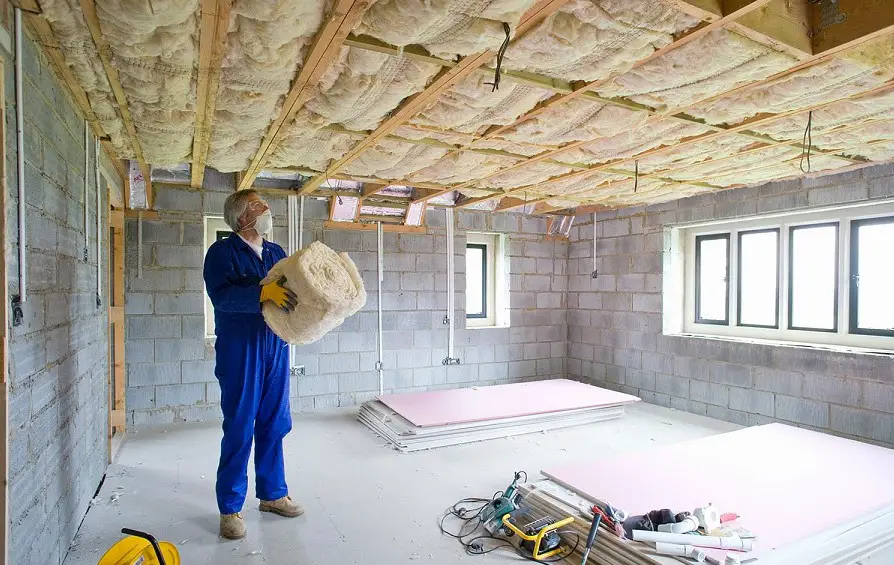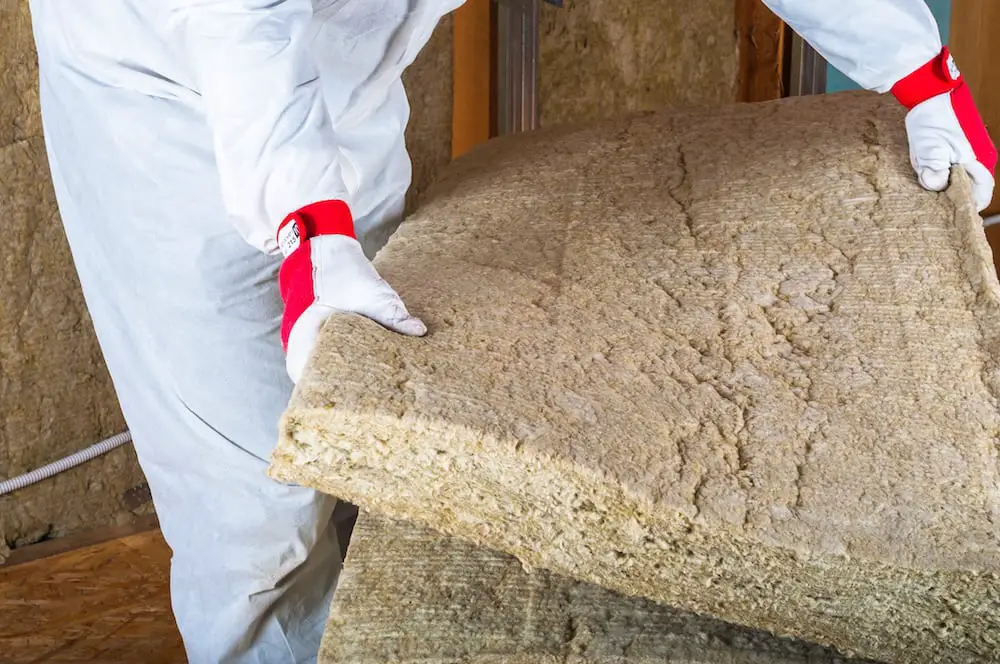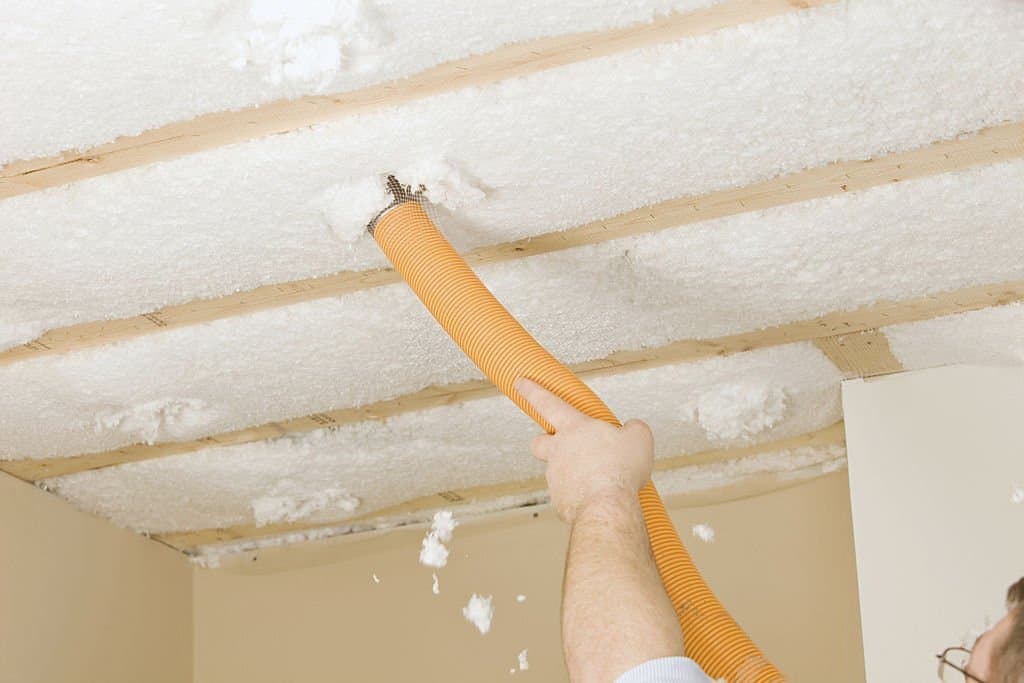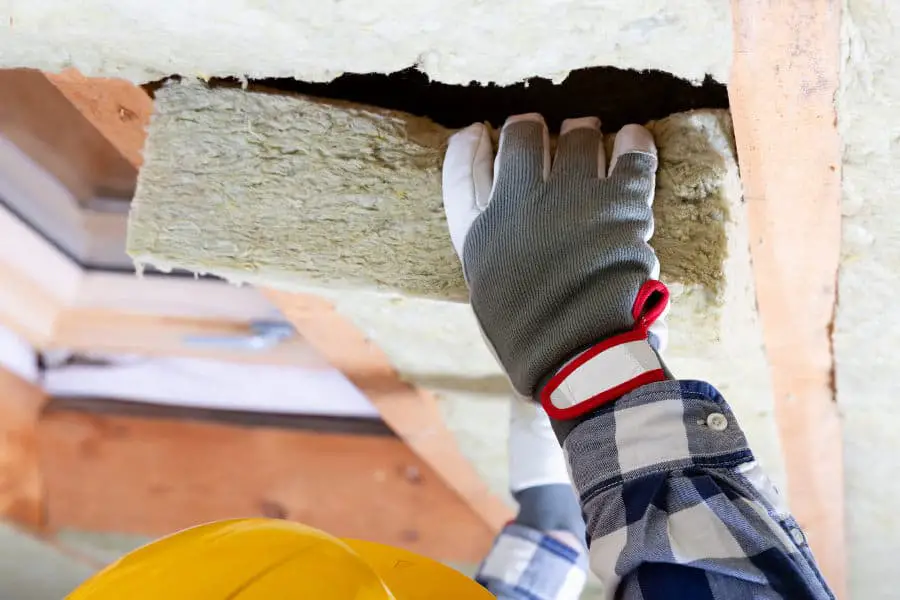When it comes to insulating your basement, you have a plethora of options. It can be daunting to decide which is the right fit for you.
While some kinds of insulation may be cheaper and easier to install, such as fiberglass rolls, other types may give you more bang for your buck and help increase energy efficiency over time, such as spray foam insulation.
One decision that may confuse homeowners is whether to use faced or unfaced insulation in their basement ceilings.
Faced insulation includes a paper or plastic layer on one side that helps stop cold air from passing through the material.
Unfaced insulation does not have this barrier included in the material. Is insulating your basement ceiling worth it? Will it help to prevent heat loss?
In this article, we’ll discuss the pros and cons of both faced and unfaced insulation so that you can make an informed decision about what’s best for your specific basement needs.

Contents
- 1 Benefits of installing basement ceiling insulation
- 2 Basement ceiling insulation pros and cons: Fiberglass, Spray Foam, Stones Wool, and Foam Board Insulation
- 3 Types of basement insulation
- 4 Tips for installing basement ceiling insulation correctly
- 5 Insulating basement ceilings: cost-effectiveness
- 6 Advantages and disadvantages of faced vs unfaced insulation
- 7 Factors to consider when selecting basement ceiling insulation
- 8 R-Value and U-Value for different types of insulation for the basement ceiling
- 9 Steps for installing faced and unfaced insulation in the basement ceiling
- 10 FAQs
- 11 Conclusion
Benefits of installing basement ceiling insulation
Basement ceiling insulation is a great way to save money on energy bills and reduce noise transmission from outside sources. It can be pitched or unfaced, and there are several types of insulation available.
Basement insulation is energy efficient, it will keep warm air in the living space from spreading, especially if basement walls are also insulated.
If you insulate your basement ceiling you won’t experience heat loss.
Fiberglass is a lightweight and affordable material that can be found in rolls or batts. Spray Foam is sprayed directly onto ceilings, walls, or floors and hardened within minutes.
Foamboard is a rigid board made from polystyrene foam with an adhesive backing that allows for easy installation onto walls or ceilings before drywall or other finishing materials are installed over top.
Stone Wool is a light but strong material that’s easy to install and doesn’t require sewing together pieces. It also offers excellent fire protection and soundproofing qualities.
Basement ceiling insulation pros and cons: Fiberglass, Spray Foam, Stones Wool, and Foam Board Insulation
Are you ready to insulate basement ceiling? When choosing between faced and unfaced insulation in your basement ceiling, understanding the pros and cons of each material or product is essential.
- Fiberglass is a relatively affordable type of insulation but can be prone to absorbing moisture and mold growth.
- Spray foam offers excellent insulation, moisture barrier, and soundproofing abilities, while stone wool insulation is known for its sturdiness and fire-resistant capabilities.
- Foam board insulation is an attractive option due to its affordability and ease of installation, but its ability to resist fire isn’t as great as the other materials mentioned.
Types of basement insulation
So, what type of insulation should you choose to insulate your basement ceiling? It depends on a few factors—including your budget, the climate in which you live, and any unique features of your home.
The most popular types of basement insulation are fiberglass, spray foam, stone wool, and mineral wool insulation.
Fiberglass insulation
Let’s start with fiberglass insulation. This is the most common type of insulation—it’s easy to install, fairly lightweight, and not too expensive.
Plus, fiberglass insulation is fire-resistant and a great way to reduce sound transmission from room to room.
However, it can also be difficult to handle due to its irritating fibers and can easily become damaged during installation or removal.
Spray foam insulation
On the other hand, spray foam insulation is more expensive than fiberglass but allows for a much better seal on ceilings and walls as it cures into thick solid foam as a moisture barrier that helps keep the temperature controlled in colder climates.
Plus, spray foam is air-seal certified and helps increases the R-value (insulating power) by 15-20%. But be warned: installation can be complicated and even dangerous if not done correctly.
Wool insulation
Finally, there’s stone wool insulation—a newer option that’s becoming increasingly popular due to its durability, fire resistance, and environment-friendly properties (made from recycled glass).
Plus, stone wool helps reduce noise transmission more effectively than fiberglass or panels do.
However, it tends to be more expensive than both fiberglass and spray foam insulation—so consider this if budget is a top concern for you! We recommend insulating your basement walls as well for more energy efficiency.

Tips for installing basement ceiling insulation correctly
When installing insulation in your basement ceiling (or unfinished basement), it is important to choose the right type of insulation for your room and consider whether to use a faced or unfaced one.
Faced insulation is more energy efficient, preventing heat loss, keeping warm air from flowing away, and preventing air leakage and mold growth. When installing the insulation, make sure it fits snugly between joists, rafters, and other framing members without any gaps.
If it is too big for a space, cut it carefully with a utility knife and attach netting or other secure material over the top. Finally, use a plastic vapor barrier around pipes and ducts to block moisture from infiltrating through them.
This will help ensure that the finished product is as effective as possible at keeping your basement warm and energy costs low.
Insulating basement ceilings: cost-effectiveness
Faced insulation is an affordable and sensible choice for the basement ceiling, as it is easy to find and install and can be installed in any kind of living space.
It provides an extra layer of protection from moisture build-up, and mold growth, but if exposed to wet conditions, the paper or foil backing will eventually fail and existing insulation may need to be replaced.
Unfaced insulation offers little to no protection from moisture but is usually more cost-effective to buy and install.
Investing in quality insulation could mean big savings in energy costs over time, providing peace of mind that your home’s energy bills will remain at a minimum while ensuring your family stays comfortable all year round.
The small difference suggests that faced insulation costs about $0.10 to $0.25 more per square foot than unfaced insulation, which is most likely due to the vapor barrier.
Advantages and disadvantages of faced vs unfaced insulation
When it comes to putting insulation in the ceilings in your basement, you’ll need to choose between faced and unfaced insulation. Each type of insulation offers its advantages and disadvantages.
Advantages of faced insulation
Faced insulation comes with a vapor barrier and vapor retarder (the “facing”), so it offers added protection from moisture and other elements.
The decreased moisture content creates an added level of protection for your home, as moisture can lead to issues like rot, mold, and corrosion.
Faced insulation is available in long rolls or batts that are typically precut to fit basic basement dimensions.
Advantages of unfaced insulation
Unfaced insulation is much simpler to install and offers complete coverage without the extra cost associated with the facing.
If you want to put up more than one layer of insulation, unfaced is the way to go. Its open structure also creates more airflow, which can help with heating and cooling costs.
Each type has its pros and cons; whether faced or unfaced is the right choice for you depending on your needs and budget. The important thing is that you choose a quality insulation material that meets your needs.

Factors to consider when selecting basement ceiling insulation
When selecting the right insulation for the ceilings of your basement (or unfinished basement), there are a few factors that should be considered.
Faced vs unfaced
Faced insulation comes with a vapor barrier or paper sheet. Unfaced insulation does not come with this barrier and only has an air barrier. It is important to choose the right type of insulation as moisture can be an issue in basements.
Vapor barriers can help reduce the risk of mold development due to moisture buildup, which is why many homeowners prefer faced insulation for their basement ceilings.
Types of insulation
Fiberglass, stone wool, or foamboard are all available for basement ceilings, with fiberglass and stone wools providing a thermal blanket to keep heated air in and cold drafts out.
Foamboard insulation provides both air and vapor barriers, making it more appealing than fiberglass or stone wool.
Fire rating
Fire rating is an important factor when selecting basement ceiling insulation, as some insulations carry higher fire ratings than others. This is especially important if you plan on having any appliances in the basement area, such as a furnace or water heater.
Make sure to review all fire rating information carefully before deciding to ensure the safest option for your home’s needs.
R-Value and U-Value for different types of insulation for the basement ceiling
Knowing the R-value and U-values of your chosen insulation is important when choosing the best type for your basement. R-value is a measure of how much heat is retained from one side to another, and it’s usually expressed in terms of “thermal resistance”.
The higher the R-value, the greater the degree of thermal resistance. U-values measure the rate of heat transfer through a material or set of materials (e.g., insulation). The lower the U-value, the less heat is transferred through it.
When researching different types and brands of insulation, some key characteristics determine their R-values:
- Type. Different types range from fiberglass to spray foam to mineral wool.
- Quality. Some insulation products have better performance than others.
- Thickness. The thickness can affect its R-value and U-Value.
For example, fiberglass rolls offer an R-value of between 3.1 to 4.3 per inch of thickness and a U-value between 0.2 to 0.25 per inch. Spray foam has an R-value between 6 and 7 per inch, and a U-value between 0.1 and 0.15 per inch.
Mineral wool ranges from 2/3rds to 4 per inch for an R-value, with a U value range from 0.12 upwards depending on density factors such as airspaces in material cavities in construction assemblies or density adjustment amounts in insulation fills, etc…
When you’re considering adding insulation to your basement ceiling, be sure to evaluate not only cost but also other factors including power efficiency, soundproofing capabilities, and fire ratings before making a decision that fits your needs best!
Steps for installing faced and unfaced insulation in the basement ceiling
Faced and unfaced insulation are two materials that can be used to add insulation to a basement ceiling.
Faced insulation is designed with a thin layer of paper or foil facing on one side, making it easier to install and keep in place.
Unfaced insulation does not have this layer, making it more difficult to keep in place during installation. The same steps apply to both materials.
Now let’s get into the steps:
- Measure the area you want to insulate and figure out how many batts of insulation you need.
- Check for obstructions in your walls like cables, pipes, and conduit.
- Cut your batts to fit between your joists using scissors or a utility knife.
- Be sure the paper or foil side of your batt is facing downwards so that when it’s installed correctly, this side will be facing away from your living space.
- Secure each batt in place between your joists with metal clips or staples.
- Add a vapor barrier over the top of the batts if there are any extra gaps between them as this helps prevent moisture buildup.

FAQs
What type of insulation should I use in my basement ceiling?
Basement ceiling insulation options vary. Depending on your priorities and budget, foam board, fiberglass insulation, spray foam, Rockwool mineral wool, cellulose, and mineral wool are all good options. Before choosing insulation, consider moisture resistance, soundproofing, and installation ease.
Can you use unfaced insulation in basement ceiling?
Basement ceilings can use facing or unfaced insulation, depending on your needs and priorities. Facing insulation prevents moisture buildup and protects living space.
What is the best way to insulate a basement ceiling?
Insulating a basement ceiling is difficult due to pipes, wires, and interconnected beams, so it is important to hire a professional who has the right skills and equipment. Sprayed foam insulation, batts between floor joists, and foundation wall insulation are common options.
Which way should I face my basement insulation?
Install faced insulation with the vapor barrier facing the conditioned space, while unfaced insulation should face the ground in an unheated basement.
Conclusion
The decision of whether to use faced or unfaced insulation in your basement ceiling is based on personal preference, budget, and the specific needs of your home.
Both options are effective at providing sound and temperature insulation, but you need to take into account the complexity of wiring and structural structures when deciding which insulation material is best for you.
No matter which option you decide to go with, you’ll enjoy the cost savings and reduced energy use that comes with it. With the right insulated basement, you can make your home more comfortable and reduce your energy bills.
Read More: Basement Insulation Options and Solutions



